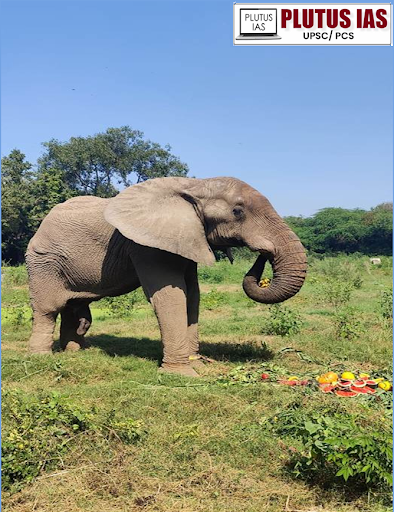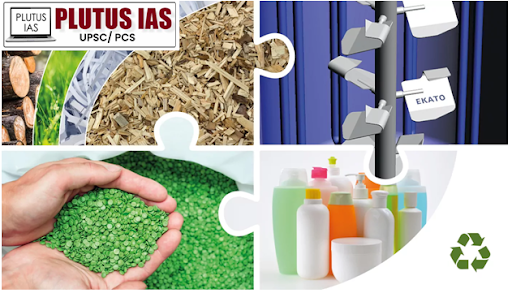15 Oct PRELIMS BITs: African Elephant, Biopolymer,
This article covers “ prelims related topics African Elephant and Biopolymer.
SYLLABUS MAPPING:
GS: General issues on Environmental ecology, Bio-diversity, and Climate Change
FOR PRELIMS:
What is biopolymer: applications examples? African elephant: features, comparison with Asiatic Elephant.
African elephant
WHY IN THE NEWS:
Union Minister of State for Environment, Forest, and Climate Change, Shri Kirti Vardhan Singh’s efforts to improve the health and habitat of the African elephant ‘Shankar’ are showing results. Recently, ‘Shankar’ was freed from his chains and seen walking actively in his enclosure.
key facts about African elephants:
Genus and Species: Belong to the genus Loxodonta.
Two species: African bush elephant (L. africana) and African forest elephant (L. cyclotis).
Physical Characteristics:
Both species are social herbivores with grey skin.
Differences include tusk size and color, ear shape and size, and skull structure.
Conservation Status:
Both species are at risk of extinction according to the IUCN Red List:
African bush elephant: Endangered.
African forest elephant: Critically endangered.
Threats include habitat loss, fragmentation, and poaching for ivory.
Size:
The African bush elephant is the largest terrestrial animal, with females measuring 2.2–2.6 m (7.2–8.5 ft) at the shoulder.
Distribution and Habitat:
Found in Sub-Saharan Africa, inhabiting:
1. Sahelian scrubland
2. Arid regions
3. Tropical rainforests
4. Mopane and miombo woodlands
African forest elephants are primarily located in Central and West Africa.
Social Structure:
Both species live in family units led by a matriarch (an older female).
Family units consist of adult females, their daughters, and subadult sons.
African forest elephant groups are less cohesive compared to bush elephant groups, likely due to fewer predators.
Reproduction:
Female elephants have a long gestation period of about 22 months.
Typically, a single calf is born, although twins can occur rarely.
Calves are cared for by the mother and other females in the family unit, receiving support and protection.
Comparison Table between the Indian elephant and the African elephant:
| Feature | Indian Elephant (Elephas maximus indicus) | African Elephant (Loxodonta africana and Loxodonta cyclotis) |
| Size | Smaller; males: ~3.2 m (10 ft), females: ~2.54 m (8.3 ft) | Larger; males: ~3.3 m (10.8 ft), females: ~2.7 m (8.9 ft) |
| Weight | Males: up to 5,400 kg (11,900 lb), females: up to 4,160 kg (9,170 lb) | Males: up to 6,000 kg (13,200 lb), females: up to 3,500 kg (7,700 lb) |
| Body Shape | Convex back with highest point on the head | Concave back with highest point on the head |
| Skull Shape | Broader skull with a concave forehead | More elongated skull |
| Ears | Large, laterally folded ears | Larger ears (especially in bush elephants) |
| Skin Color | Grey, smooth skin | Grey, rough skin |
| Trunk | Large trunk | Large trunk |
| Diet | Consumes up to 150 kg (330 lb) of plant matter per day; varied diet | Consumes a variety of vegetation, including leaves, fruits, and bark |
| Population | Estimated 23,000 to 41,000 individuals; ~27,312 in India (2017 census) | Approximately 415,000 individuals (as of recent estimates) |
| Conservation Status | Endangered (IUCN Red List since 1986) | African bush elephant: Endangered; African forest elephant: Critically endangered |
| Distribution | Primarily found in India; also in Nepal, Bangladesh, Bhutan, Myanmar, Thailand, Malaysia, Laos, Cambodia, Vietnam, and small populations in China | Found in Sub-Saharan Africa, inhabiting various ecosystems |
| Cultural Significance | Revered in Hinduism as a form of Lord Ganesha; a national heritage animal in India | Cultural significance varies across regions; often seen as a symbol of strength and wisdom |
| Social Structure | Lives in family units led by a matriarch | Lives in matriarchal family units; bush elephants have tighter social bonds than forest elephants |
Biopolymers
Why in the news?
In a significant move to position India as a global economic leader and a key player in environmental sustainability, Minister Dr. Jitendra Singh inaugurated the country’s first Demonstration Facility for Biopolymers in Pune.

KEY FACTS:
Biopolymers are natural polymers produced by living organisms, consisting of monomeric units bonded together. They play crucial roles in various biological functions and processes and are found in all living organisms, including plants, animals, and microorganisms.
Examples of Biopolymers:
Polynucleotides: RNA and DNA, long chains of nucleotides.
Polypeptides: Proteins and shorter amino acid chains.
Polysaccharides: Starch, cellulose, and alginate, which are chains of sugar carbohydrates.
Applications of Biopolymers:
Food Industry: Used as hydrocolloids to enhance food shelf life and improve the stability and texture of emulsion-based products.
Manufacturing: Serve as matrices or substrates in bio-based plastics.
Packaging: Employed in environmentally friendly packaging solutions.
Biomedical Engineering: Applied in tissue engineering, drug delivery systems, and implantable devices.
Soil Stabilization: Help strengthen soil and combat desertification in drylands.
Gas and Vapor Sensors: Promising materials for sensors due to their biocompatibility and unique properties.
Polylactic Acid (PLA): A BIOPOLYMER
Definition: Polylactic Acid (PLA) is a widely used bioplastic derived from renewable resources, primarily corn starch or sugarcane. It is a biodegradable and compostable material that has gained popularity in various applications due to its eco-friendly properties.
Key Features of PLA:
Biodegradability: PLA breaks down into natural elements in industrial composting conditions, reducing plastic waste.
Renewable Resource: Made from plant-based materials, PLA is a sustainable alternative to petroleum-based plastics.
Properties:
Thermal Resistance: PLA has a lower melting temperature compared to traditional plastics, which can limit its use in high-heat applications.
Strength: It offers good tensile strength but can be brittle under certain conditions.
Environmental Impact: While PLA is compostable, it requires specific conditions to break down effectively, and its production still involves energy use and land resources.
Applications:
Packaging: Commonly used for food packaging, disposable cutlery, and bags.
3D Printing: Popular among hobbyists and professionals due to its ease of use and variety of colors.
Biomedical Devices: Utilized in drug delivery systems and sutures because of their biocompatibility.
Download plutus ias current affairs eng med 15th Oct 2024
Prelims questions:
Q. With reference to the Indian and African elephants, Consider the following statement:
1. The Indian elephant is heavier than the African elephant.
2. The Indian elephants show sexual dimorphism, unlike African elephants.
3. The Indian elephant is widely lives in the family like the African Elephant
4. Indian elephants are herbivores, unlike the African elephants.
How many of the above-given statements are correct?
A. Only one
B. Only two
C. Only three
D. All four
ANSWER: A
Q.2. Which of the following statements are correct about Polylactic Acid (PLA)?
1. The PLA is a non-degradable bioplastic obtained from Starch.
2. PLA is a sustainable alternative to petroleum-based plastics.
3. The PLA is widely used in food packaging, disposable cutlery, and bags.
Select the correct answer using the code given below:
A. Only one
B. Only two
C. All three
D. None
ANSWER: B



No Comments